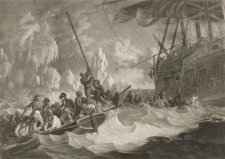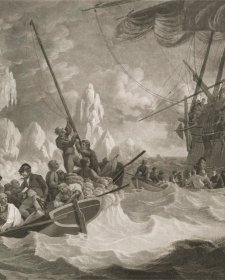Edward Riou (1762-1801), naval officer, began his career with the Royal Navy at the age of twelve. By age fifteen he was a midshipman and joined Captain Charles Clerke's Discovery which, with James Cook's Resolution, was about to embark upon Cook's third voyage to the Pacific. It is said that Riou received instruction in chart-making from William Bligh, the Resolution's master, during the voyage. After Cook's death in Hawaii, Clerke assumed command of the expedition and transferred to the Resolution, taking Riou with him. Riou was promoted to lieutenant in October 1780 and appointed to a vessel sent to serve in the West Indies. Between 1782 and 1788, he served on British ships at home and in North America; while also spending a significant period of time on half-pay. In April 1789, he was appointed to the command of HMS Guardian, a modified frigate commissioned with the transport of a cargo of food, livestock, equipment and convicts for the struggling settlement at Port Jackson.
The Guardian left England in September 1789 and made good progress to Cape Town, where Riou took on more livestock and provisions. On the evening of the 24 December 1789, two weeks after leaving Cape Town, the ship struck an iceberg; the collision opened a huge gash in the Guardian's hull and tore off its rudder and part of the keel. On Christmas morning, the crew attempted to remedy the damage by strapping a sail along the hull, while also working desperately at pumping out the water that, in rough seas, was flooding in. Riou then ordered that all heavy objects be jettisoned to prevent the ship from sinking; livestock, guns, and cargo were thrown overboard. When all these measures failed to lessen the peril, Riou agreed to requests from some of the crew that they take to the smaller boats to escape. Altogether, about half of the people on board abandoned ship, all but 15 of these people perishing. Riou chose to remain on the Guardian with about 60 others, including 21 convicts. Through Riou's remarkable seamanship and powers of persuasion, they managed to keep the stricken vessel afloat for several weeks until it drifted within sight of the Cape. The survivors were rescued; the Guardian was beyond repair and was scuttled. The surviving convicts and salvaged cargo eventually arrived in New South Wales in June 1790, having been distributed among the ships making up the disastrous Second Fleet when they called at Cape Town. Fourteen of the convicts were immediately pardoned due to Riou's report of their conduct in assisting to save the Guardian.
Riou returned to England a hero and was formally acquitted of any blame for the loss of his ship in the obligatory court martial that followed. He was promoted to the rank of captain and, on the outbreak of the French Revolutionary Wars, served on a series of gunships, seeing action in the West Indies and Europe. Edward Riou was killed in the Battle of Copenhagen on 2 April 1801. Acting as commander of Admiral Nelson's frigates, Riou's ship Amazon was leading the assault on the Trekroner Fort when one of the British ships signalled retreat. Riou was killed in the cannon fire that struck Amazon as it showed its stern to the battery. A monument to Riou was erected in St Paul's Cathedral in 1805 and his memory was celebrated in a poem called 'The Battle of the Baltic'.







